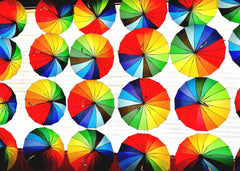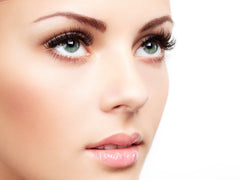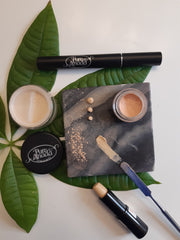Some times concealer alone just doesn't cut it. So what do you do when your concealer fails you? You colour correct, of course. I know you’re probably thinking, “Gee another product to add on?” However, if you have highly pigmented hereditary under-eye circles, you will truly appreciate what a colour corrector can do for your eyes and other areas of your face that might need colour-correcting.
Colour correctors come in several different forms from powders to creams to primers. A light dusting of a powder corrector can brighten a dull complexion or tone down overall redness after makeup application (for example these powders by Pure Anada); however, for dark under-eye circles a cream colour and specific placement work best.
First, let’s talk colour theory. I’m sure you know that colours opposite from each other on the colour wheel cancel each other out. If you don’t remember the colour wheel rules, here’s a refresher that will help you to choose the correct concealer.

Colour corrector shades
1) Green is opposite red on the colour wheel, so you’d need a green concealer to colour correct redness. This works best on blemishes or overall redness on the skin, for example sunburn or rosacea. A green tinted primer or powder would work well in this case.
2) Purple/ lavender/ lilac is opposite yellow on the colour wheel, so if you have dull yellow undertones on your entire face, you’ll greatly benefit from a purple primer or a lilac powder which will instantly brighten up your complexion. For concealing yellow spots, using a cream concealer is best.
3) Salmon/Peach concealers contain a mixture of red, orange, and yellow hues and are located across blue, purple, and green hues. Therefore, this concealer colour is best for combating dark circles, and I should know because my dark circles are something else.
4) Yellow is across purple on the colour wheel and so perfect for concealing purple or blue bruises, veins or purple undereye circles. Yellow primers are also great for evening out and brightening your skin tone before you apply foundation, and a yellow cream concealer can also work well as an eye shadow primer.
5) Orange concealers are meant for darker toned individuals who are looking to conceal dark circles or spots with discoloration.

5 easy steps to perfect correcting and concealing
1) Moisturize, moisturize, moisturize! I cannot stress this enough. The under-eye skin is not just sensitive, but it can also be dry and allow your product to crease if not prepped properly. Make sure you use a rich eye cream on the under-eye area before you begin correcting and concealing. The eye cream must be completely absorbed before applying your correctors and concealers! The Eyewaken eye cream by Cocoon Apothecary uses cornflower hydrosol to fight puffiness.
2) If you’re using a correcting primer, correcting cream or correcting liquid concealer, you’ll have to use your products in this order: 1. color correct 2. concealer 3. foundation. A colour correcting powder can be applied as a fourth step following your foundation if you feel that you need additional correcting power or you can see redness, for example, starting to come through in the middle of the day.
3) Choose the color corrector that’s appropriate for the problem you’re correcting. If you’re concerned about dark under-eye circles, focus on those. I’m a bit of a minimalist when it comes to makeup, so I wouldn’t recommend using every colour corrector available on your face to tackle all problem areas at once.
4) For creams and liquids, apply the product on your face and gently pat in using your ring finger until you have an even application. Don’t drag the colour corrector into your skin. Follow with your regular concealer following the same application method. You should not be able to tell where one product begins and the other ends. Blend, blend, blend! I bring my regular concealer down towards my cheekbone (think of it as an inverted isosceles triangle starting from your bottom lashes and fading onto the top of your cheekbone) and fade it in to my skin.
5) Apply foundation to the rest of your face blending it gently over the concealer eye area and lightly dust with a translucent powder. Try to avoid heavy powdering over the eye area since the powder will settle in fine lines and accentuate dryness and wrinkles.

What I'm currently using
The concealers I’m currently trying are 1) Pure Anada Liquid Concealer in Light (this product is a light liquid with great coverage) and 2) Pure Anada Cream Concealer in Light (this product is a cream in stick form). Concealer has been the last beauty product that I've still gone conventional because I didn't feel that the coverage was there with the previous natural products I tried. Both the Sappho and W3LL People concealers have wonderful coverage without looking cakey, but for my dark circles I'd still have to use a colour corrector. I haven't found a natural product for this yet, so I'm still using 3) Nyx Dark Circle Concealer in Light (this is cream corrector with orange undertones). I chose this shade because my dark circles have bluish undertones; the consistency of this concealer is fantastic and a small amount can go a long way. This is a vegan and cruelty-free formula.
If you suffer from dark circles and puffiness and want some easy-to-follow, natural remedies, check out my blog on 5 ways to fight dark circles and puffiness naturally!




Leave a comment